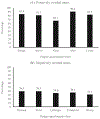Fatigue and on-duty injury among police officers: The BCOPS study
- PMID: 28160813
- PMCID: PMC6311701
- DOI: 10.1016/j.jsr.2016.11.006
Fatigue and on-duty injury among police officers: The BCOPS study
Abstract
Introduction: Policing involves inherent physical and psychological dangers as well as occupational stressors that could lead to chronic fatigue. Although accounts of adverse events associated with police fatigue are not scarce, literature on the association between chronic fatigue and on-duty injury are limited.
Methods: Participants were officers from the Buffalo Cardio-Metabolic Occupational Police Stress (BCOPS) Study. A 10-item questionnaire was administered to assess how tired or energetic the officers generally felt irrespective of sleep hours or workload. The questionnaire consisted of five positively worded and five negatively phrased items that measured feelings of vigor/energy and tiredness, respectively. Total as well as separate scores for positive and negative items were computed by summing scores of individual items. Payroll records documenting each officer's work history were used to assess occurrence of injury. Poisson regression was used to estimate prevalence ratios (PR) of injury.
Results: Nearly 40% of officers reported feeling drained. Overall prevalence of on-duty injury during the past year was 23.9%. Injury prevalence showed a significant increasing trend across tertiles of total fatigue score: 19.6, 21.7, and 30.8% for lowest, middle and highest tertiles, respectively (trend p-value=0.037). After controlling for potential confounders, a 5-unit increase in total fatigue score was associated with a 12% increase in prevalence of injury which was marginally significant (p=0.075). A 5-unit increase in fatigue score of the positively worded items was associated with a 33% increase in prevalence of injury (PR=1.33, 95% CI: 1.04-1.70, p=0.022).
Conclusion: Officers who do not feel active, full of vigor, alert, or lively had a significantly higher prevalence of non-fatal work place injury compared to their counter parts. Practical applications: With additional prospective evidence, workplace interventions designed to enhance level of energy may reduce feelings of tiredness and hence may prevent workplace injury.
Keywords: Chronic tiredness; Law enforcement; Non-fatal injuries; Work history.
Published by Elsevier Ltd.
Conflict of interest statement
Declaration of interest
The authors report no conflicts of interest. The authors alone are responsible for the content and writing of the paper.
Figures

Similar articles
-
An Exploration of Shift Work, Fatigue, and Gender Among Police Officers: The BCOPS Study.Workplace Health Saf. 2018 Nov;66(11):530-537. doi: 10.1177/2165079918754586. Epub 2018 Feb 26. Workplace Health Saf. 2018. PMID: 29480763 Free PMC article.
-
On-Duty Nonfatal Injury that Lead to Work Absences Among Police Officers and Level of Perceived Stress.J Occup Environ Med. 2017 Nov;59(11):1084-1088. doi: 10.1097/JOM.0000000000001137. J Occup Environ Med. 2017. PMID: 28816733 Free PMC article.
-
Shift work and the incidence of injury among police officers.Am J Ind Med. 2012 Mar;55(3):217-27. doi: 10.1002/ajim.22007. Epub 2012 Jan 6. Am J Ind Med. 2012. PMID: 22228219
-
Working hours, sleep, and fatigue in the public safety sector: A scoping review of the research.Am J Ind Med. 2022 Nov;65(11):878-897. doi: 10.1002/ajim.23407. Epub 2022 Jun 16. Am J Ind Med. 2022. PMID: 35711032 Free PMC article.
-
A systematic review of the current evidence regarding interventions for anxiety, PTSD, sleepiness and fatigue in the law enforcement workplace.Ind Health. 2019 Nov 29;57(6):655-667. doi: 10.2486/indhealth.2018-0088. Epub 2019 Feb 13. Ind Health. 2019. PMID: 30760652 Free PMC article.
Cited by
-
Association between chronotype and psychomotor performance of rotating shift workers.Sci Rep. 2021 Mar 25;11(1):6919. doi: 10.1038/s41598-021-86299-8. Sci Rep. 2021. PMID: 33767333 Free PMC article.
-
Relationship between fatigue severity scale and occupational injury in Korean workers.Ann Occup Environ Med. 2021 May 4;33:e15. doi: 10.35371/aoem.2021.33.e15. eCollection 2021. Ann Occup Environ Med. 2021. PMID: 34754476 Free PMC article.
-
The Curvilinear Relationship Between Career Calling and Work Fatigue: A Moderated Mediating Model.Front Psychol. 2020 Oct 30;11:583604. doi: 10.3389/fpsyg.2020.583604. eCollection 2020. Front Psychol. 2020. PMID: 33192910 Free PMC article.
-
Adopting Stimulus Detection Tasks for Cognitive Workload Assessment: Some Considerations.Hum Factors. 2024 Dec;66(12):2561-2568. doi: 10.1177/00187208241228049. Epub 2024 Jan 21. Hum Factors. 2024. PMID: 38247319 Free PMC article. Review.
-
Wearable biosensors for human fatigue diagnosis: A review.Bioeng Transl Med. 2022 May 17;8(1):e10318. doi: 10.1002/btm2.10318. eCollection 2023 Jan. Bioeng Transl Med. 2022. PMID: 36684114 Free PMC article. Review.
References
-
- Barron S (2008). Occupational stress: The emerging threat to police officers. Journal of Occupational Health and Safety - Australia and New Zealand, 24(6), 553–561.
-
- Barton J, Spelten E, Totterdell P, Smith L, Folkard S, & Costa G (1995). The Standard Shiftwork Index: A battery of questionnaires for assessing shiftwork-related problems. Work and Stress, 9(1), 4–30.
-
- Berecki-Gisolf J, Smith PM, Collie A, & Mcclure RJ (2015). Gender differences in occupational injury incidence. American Journal of Industrial Medicine, 58(3), 299–307. - PubMed
-
- Bültmann U, Kant IJ, Van Den Brandt PA, & Kasl SV (2002). Psychosocial work characteristics as rick factors for the onset of fatigue and psychological distress: rospective results from the Maastricht cohort study. Psychological Medicine, 32(2), 333–345. - PubMed
-
- Bureau of Labor Statistics [BLS] (2014). Nonfatal occupational injuries and illnesses involving days away from work by selected worker occupation and ownership, 2014. (Table.4 Number, incidence rate, and median days away from work). (http://www.bls.gov/news.release/osh2.t04.htm Last accessed 10 February 2016).
MeSH terms
Grants and funding
LinkOut - more resources
Full Text Sources
Other Literature Sources
Medical
Research Materials
Miscellaneous

